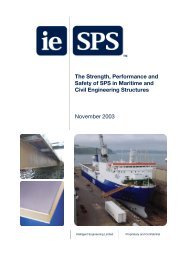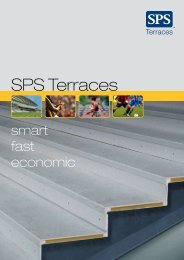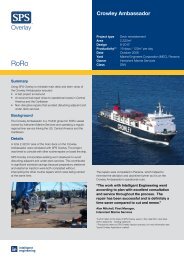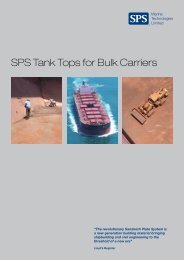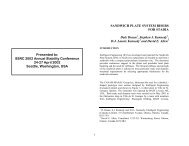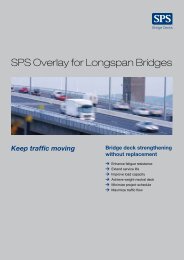<strong>SPS</strong> structures have a high inherent resistance to fatigue.<strong>The</strong> bond between the elastomer core <strong>and</strong> the face platesis virtually fatigue insensitive. Joints between <strong>SPS</strong>panels <strong>and</strong> connections <strong>of</strong> <strong>SPS</strong> panels to supportingstructure have a good inherent resistance <strong>and</strong> may bechecked using st<strong>and</strong>ard fatigue assessment techniquesalready used in the marine industry.3.3(b) Summary <strong>of</strong> <strong>SPS</strong> applications in double hulltankers<strong>SPS</strong> can replace traditional stiffened plating in the maindeck, inner <strong>and</strong> outer hull <strong>and</strong> longitudinal bulkheads ondouble hull tankers, to provide both construction <strong>and</strong>operational benefits. Without secondary stiffening, themajority <strong>of</strong> fatigue <strong>and</strong> corrosion prone details areadvantageously eliminated; <strong>and</strong> with suitably optimisedproduction techniques there are many advantages forconstruction in terms <strong>of</strong> cost <strong>and</strong> time.At the beginning <strong>of</strong> this section a list <strong>of</strong> needs for theideal ship design were suggested. In answer to thesepoints, <strong>SPS</strong> has unique properties that <strong>of</strong>fer distinctadvantages over conventional designs:• <strong>The</strong> structural simplification afforded by <strong>SPS</strong>provides the opportunity to eliminate secondarystiffeners <strong>and</strong> their associated connections withprimary structures such as transverse web frames <strong>and</strong>bulkheads.• In comparison to its all-steel counterpart, thefabrication <strong>of</strong> an <strong>SPS</strong> structure has substantially lesslabour input, reduced weld lengths <strong>and</strong> volumes,reduced surface areas for coating <strong>and</strong> reduced hullweight.• <strong>The</strong> s<strong>and</strong>wich plate dissipates highly localisedbending strains in the plating to the primary structuralframing, thus eliminating hard spots associated withcoating breakdown at stiffener intersections.• <strong>The</strong> elimination <strong>of</strong> stiffeners <strong>and</strong> connectionsremoves a source <strong>of</strong> high risk for structural failures.<strong>The</strong> impact resistance <strong>of</strong> <strong>SPS</strong> also provides improvedperformance against extreme event loading such aswave impact, slamming, grounding <strong>and</strong> collisions.• <strong>The</strong> reduced surface area <strong>of</strong> internal structures <strong>and</strong>clutter-free layout enable faster <strong>and</strong> better coatingapplication. Since paint coatings will be easier toapply <strong>and</strong> the amount <strong>of</strong> free edges <strong>and</strong> cornersgreatly reduced, the reliability <strong>of</strong> coatings will begreatly enhanced with <strong>SPS</strong> structures. This is a highcost aspect <strong>of</strong> ship maintenance, <strong>and</strong> with a currentcost <strong>of</strong> up to $35 per square meter for blasting,cleaning <strong>and</strong> paint application, there are significantlife-time savings to be made.• Inspection <strong>and</strong> maintenance are greatly reduced in<strong>SPS</strong> structures. Tank inspection will be faster <strong>and</strong>more reliable. With less cluttered structural layouts,tank drainage <strong>and</strong> cleaning will be faster <strong>and</strong> moreeffective <strong>and</strong> will help avoid the build up <strong>of</strong> silt <strong>and</strong>mud in ballast tanks.• Permanent deformation <strong>of</strong> conventional stiffenedpanels is common <strong>and</strong> <strong>of</strong>ten requires steelreplacements <strong>and</strong> strengthening during a ship’s life.<strong>The</strong> ability <strong>of</strong> <strong>SPS</strong> to absorb damage from waveimpact, grounding <strong>and</strong> collisions whilst resistingperforation <strong>of</strong> the hull, will in many cases avoidflooding <strong>and</strong> enable faster <strong>and</strong> safer recovery <strong>of</strong> agrounded ship.• <strong>SPS</strong> also allows different metals to be used on eitherside <strong>of</strong> the s<strong>and</strong>wich. This <strong>of</strong>fers new solutions tochemical tanker designers, by allowing a costeffective means <strong>of</strong> constructing tanks with stainlesssteel internal surfaces.In addition to hull structures, <strong>SPS</strong> will find many otherapplications in ships. Inherent properties, such as fireresistance <strong>and</strong> the attenuation <strong>of</strong> noise <strong>and</strong> vibration,mean that <strong>SPS</strong> will have useful applications in key areassuch as accommodation <strong>and</strong> machinery spaces. <strong>SPS</strong> mayalso provide solutions for double-hulling <strong>of</strong> existingsingle skin ships where the elimination <strong>of</strong> secondarystiffeners will minimise the impact on access to the innerhull, <strong>and</strong> hence maximise cargo carrying capacity.4. DESIGN STUDY OF SMALL PRODUCTSTANKER4.1 BACKGROUNDAs part <strong>of</strong> Intelligent Engineering’s ongoingdevelopment programme, a design study was undertakenfor the cargo tank section <strong>of</strong> a 14k dwt double-hulledproducts tanker.A conventional steel design for the ship was used as areference point for the <strong>SPS</strong> design study <strong>and</strong> the resultsare presented here in summary form. <strong>The</strong> objective <strong>of</strong>the work was to investigate the feasibility <strong>of</strong> using <strong>SPS</strong>construction on a double hull tanker <strong>and</strong> to makecomparisons between the two designs, with a view toassessing <strong>and</strong> quantifying the benefits <strong>of</strong> <strong>SPS</strong>construction. Lloyd’s Register’s Rules <strong>and</strong> ShipRightDirect Calculation Procedures were used as a basis forscantling design.<strong>SPS</strong> can replace the traditional stiffened plate <strong>of</strong> the maindeck, inner <strong>and</strong> outer side shell, double bottom <strong>and</strong>centreline longitudinal bulkhead <strong>of</strong> the tanker to provideboth construction <strong>and</strong> operational benefits. Withoutsecondary stiffening, the majority <strong>of</strong> fatigue <strong>and</strong>corrosion prone details are advantageously eliminated.<strong>The</strong> s<strong>and</strong>wich plate dissipates highly localised bendingstrains in the plating into the primary structural framing,thus eliminating the ‘hard spots’ associated with coatingbreakdown at stiffener intersections.In comparison to its all-steel counterpart, the fabrication<strong>of</strong> an <strong>SPS</strong> structure has substantially less labour input,reduced weld lengths <strong>and</strong> volumes, reduced surface areasfor coating in combination with improved coating6
application, <strong>and</strong> reduced hull weight. In operation thesmooth surfaces <strong>of</strong> <strong>SPS</strong> plating allow for better ballasttank drainage <strong>and</strong> cleaning <strong>The</strong> principle dimensions <strong>of</strong>the tanker are listed in Table 4.1.between the main web frames. Figure 4.2 shows askeletal view <strong>of</strong> the conventional steel mid-section; theinner bottom, inner skin <strong>and</strong> longitudinal bulkhead areremoved to provide a clear view <strong>of</strong> the structure.Table 4.1 Principal DimensionsLength overall: 144.0 mLength between perpendiculars: 134.5 mBreadth: 21.50 mDepth: 11.30 mDraft: 7.65 mDeadweight: 14000 tonnesCargo capacity (98%): 16660 m 3Ballast capacity: 6610 m 34.2 DESCRIPTION OF CONVENTIONAL AND<strong>SPS</strong> DESIGNDuring the design study both the conventional steel <strong>and</strong><strong>SPS</strong> designs underwent several iterations to optimise thescantlings, following the results <strong>of</strong> the FE analysescarried out using the ShipRight design assessmentprocedures. <strong>The</strong> following information is based on thefinal set <strong>of</strong> scantlings determined.Figure 4.2 Steel Tanker Structural LayoutDuring the design study it was determined that the <strong>SPS</strong>design could use a 3.5m spacing <strong>of</strong> the web frames. Allsecondary longitudinal stiffeners were eliminated fromthe structure. Double bottom girders have beenintroduced, along with an additional intermediate stringeron the side structure <strong>and</strong> centreline bulkhead. <strong>The</strong>increased floor spacing along with the additional girdersFigure 4.3 <strong>SPS</strong> Tanker Structural LayoutFigure 4.1 Sketch <strong>of</strong> Midship Section(14k dwt Products Tanker)<strong>The</strong> conventional steel design uses a st<strong>and</strong>ardconfiguration with a centreline bulkhead <strong>and</strong> “J” tankscovering the side structure <strong>and</strong> double bottom. <strong>The</strong> tanktop has a small rise <strong>of</strong> floor to aid tank drainage <strong>and</strong>stripping. Figure 4.1 shows the layout <strong>of</strong> the midshipsection, including basic dimensions. <strong>The</strong> transverseframe spacing is 3m <strong>and</strong> the longitudinal stiffenerspacing is 675mm. <strong>The</strong>re are no intermediatelongitudinal girders between the centreline bulkhead <strong>and</strong>the girders beneath the hopper side knuckle on the innerbottom. In the bilge area, additional webs are provided<strong>and</strong> stringers help maintain optimum panel sizes for the<strong>SPS</strong> plating on the external <strong>and</strong> internal hull plating.Finally, as the secondary stiffeners have been eliminated<strong>and</strong> access through the inner bottom is much improved,the height <strong>of</strong> the double bottom can be reduced by600mm, which has the additional advantage <strong>of</strong> increasingthe cargo capacity by around 6%. Figure 4.3 shows asimilar skeletal view <strong>of</strong> the <strong>SPS</strong> hull section.Table 4.2 Comparison <strong>of</strong> ScantlingsConventionalStructural Component SteelScantlingsInner Plate14 mmBottom &HopperLongitudinals HP 320x12Outer Plate14 mmBottom Keel Plate 16 mm<strong>SPS</strong> Scantlings<strong>SPS</strong> 7-50-7.5<strong>SPS</strong> 7-50-77



